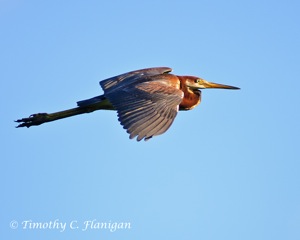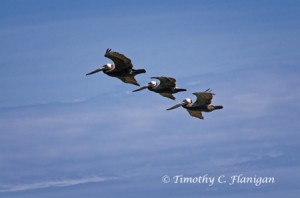Wingshooting upland game birds is an especially challenging sport that is done with shotguns and fine shot. Wingshooting with a camera is somewhat similar and perhaps even more challenging. Flying bird photography also is especially rewarding because photos of birds in flight are so much more interesting than images of perched birds.
 Similar to shotgunning, the photographer ,too, must lead the target and allow some space in the frame, ahead of the flying subject into which the action can continue. This sight picture works well for gun and camera.
Similar to shotgunning, the photographer ,too, must lead the target and allow some space in the frame, ahead of the flying subject into which the action can continue. This sight picture works well for gun and camera.
To facilitate action shooting, many modern digital cameras offer a continuous auto-focus option that enables photographers to track flying birds while maintaining sharp focus. The focus sensor must be locked onto the bird’s eye by holding the shutter release down and firing successive frames, in the camera’s continuous high-speed mode. Be careful to keep all of the bird in the frame.
Happily, most birds are diurnal, and lots of daylight is needed to enable the use or fast shutter speeds, such as 1000/second or faster, to stop the action. Try setting your camera on shutter priority, ISO 400 and select the fastest shutter speed possible in the available light. The camera will select a suitable aperture (F-stop).
 When photographing birds in open skies, select the “Center weighted” or “Center” mode for the camera’s light meter.
When photographing birds in open skies, select the “Center weighted” or “Center” mode for the camera’s light meter.
Shooting flying birds is not easy, but it is great fun. In addition it is not limited by seasons or bag limits and no license is needed. To maximize photo opportunities, set up in a location where birds fly to and fro between a food or water source and or a roost site. This can be as simple watching a backyard bird feeder or bird bath.
Be certain to keep the sun at your back and, if possible, select a background that contrasts with the subject, i.e. dark conifers behind doves in flight. Shoot lot of frames and you’re almost certain to capture a few truly impressive images.
 Tim Flanigan is the Southcentral Field Editor for the Pennsylvania Outdoor Times, a contributing photographer to The Upland Almanac, The Ruffed Grouse Society, Buckmasters and Buckmasters On-Line. He is published inWildfowl Carving magazine, North American Whitetail magazine, Westsylvania magazine and Game and Fish Publications. His photography can also be seen on the covers of Pennsylvania Game News magazine and its annual calendar.
Tim Flanigan is the Southcentral Field Editor for the Pennsylvania Outdoor Times, a contributing photographer to The Upland Almanac, The Ruffed Grouse Society, Buckmasters and Buckmasters On-Line. He is published inWildfowl Carving magazine, North American Whitetail magazine, Westsylvania magazine and Game and Fish Publications. His photography can also be seen on the covers of Pennsylvania Game News magazine and its annual calendar.
He enjoys membership in the Outdoor Writers Association of America (OWAA), the Southeastern Outdoor Press Association (SEOPA), the North American Nature Photography Association, the Professional Outdoor Media Association (POMA) and the National Association of Photoshop Professionals. He is also a Past-President and member of both the Pennsylvania Outdoor Writers Association and the Mason/Dixon Outdoor Writers Association. Membership he also enjoys includes the Bedford County Arts Council, Allegany Area Art Alliance and the Allegany Arts Council.
Tim, and his wife Debbie operate Nature Exposure, an outdoor writing and photography marketing business in Bedford, Pennsylvania, that specializes in supplying content and photography to outdoor publications. Nature Exposure also showcases limited editions of Tim’s award-winning fine art photography, as both framed giclée prints on canvas, as well as premium papers along with his notecard collection. His work is exhibited and sold at various art galleries, art shows and festivals. For more information, please visit their new website: www.natureexposure.com. Tim at tim-natureexposure@comcast.net, or call 814-623-7865.
Tim Flanigan has been producing top-quality photographic images for the print media for more than 30 years.Tim, and his wife, Debbie, operate Nature Exposure, an outdoor writing and photography marketing business in Bedford, Penn. View all posts by Tim Flanigan
We call Tim Flanigan our “professor” here at The WON, Gretchen, and you can see why! He is a great teacher and besides, he has that “look.”
Great Read Tim! Shooting waterfowl with the camera is one of my most favorite things, and yes.. there goes that 400mm out of the blind moving right along with the shotgun barrels…LOL
I especially liked that you pointed out that shooting with a camera a shooting with a gun share some similar attributes and skill sets when dealing with the birds on the wing! Thanks for sharing!